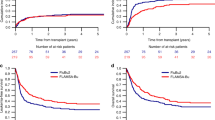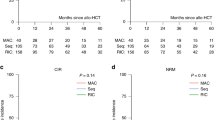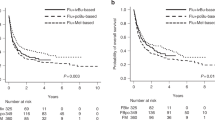Abstract
In the present study, reduced toxicity (FluBu3) and myeloablative (BuCy) conditioning were compared in patients with AML who received first allogeneic HSCT in MRD-negative CR1. The study included 124 adult patients who underwent HSCT from an HLA-matched (8/8) sibling, unrelated, or 1-locus mismatched (7/8) unrelated donor (MMUD). The median age was 45 years and intermediate cytogenetics comprised majority (71.8%). The 2-year OS, RFS, CIR and NRM for BuCy (n = 78, 62.9%) and FluBu3 (n = 46, 37.1%) groups were 78.3% and 84.5% (p = 0.358), 78.0% and 76.3% (p = 0.806), 7.7% and 21.5% (p = 0.074) and 14.3% and 2.2% (p = 0.032), respectively. At the time of data cut-off, relapse and NRM were the main causes of HSCT failure in each of the FluBu3 and BuCy arms. Among patients, 75% of relapsed FluBu3 patients had high-risk features of either poor cytogenetics or FLT3-ITD mutation compared with 16.7% of BuCy patients. The majority of NRM in the BuCy group was due to GVHD (73%), half of whom received MMUD transplantation. To conclude, the FluBu3 reduced toxicity conditioning showed comparable post-transplant OS and RFS to BuCy and was associated with significantly reduced NRM that was offset by a trend towards higher risk of relapse even in MRD-negative CR1 population.
This is a preview of subscription content, access via your institution
Access options
Subscribe to this journal
Receive 12 print issues and online access
$259.00 per year
only $21.58 per issue
Buy this article
- Purchase on Springer Link
- Instant access to full article PDF
Prices may be subject to local taxes which are calculated during checkout


Similar content being viewed by others
Data availability
The datasets generated during and/or analyzed during the current study are available from the corresponding author on reasonable request.
References
Mohty R, El Hamed R, Brissot E, Bazarbachi A, Mohty M. New drugs before, during, and after hematopoietic stem cell transplantation for patients with acute myeloid leukemia. Haematologica. 2023;108:321–41.
Bittencourt MCB, Ciurea SO. Recent Advances in Allogeneic Hematopoietic Stem Cell Transplantation for Acute Myeloid Leukemia. Biol Blood Marrow Transpl. 2020;26:e215–e221.
Cho B-S, Min G-J, Park S, Park S-S, Shin S-H, Yahng S-A, et al. Haploidentical vs matched unrelated donor transplantation for acute myeloid leukemia in remission: A prospective comparative study. Am J Hematol. 2021;96:98–109.
Wang ES. Treating acute myeloid leukemia in older adults. Hematology. 2014;2014:14–20.
Min G-J, Cho B-S, Park S-S, Park S, Jeon Y-W, Shin S-H, et al. Geriatric assessment predicts nonfatal toxicities and survival for intensively treated older adults with AML. Blood. 2022;139:1646–58.
Park S, Min GJ, Park SS, Yahng S-A, Jeon Y-W, Shin S-H, et al. Comparison of Myeloablative (CyTBI, BuCy) versus Reduced-Intensity (FluBu2TBI400) Peripheral Blood Stem Cell Transplantation in Acute Myeloid Leukemia Patients with Pretransplant Low WT1 Expression. Biol Blood Marrow Transpl. 2020;26:2018–26.
Ciurea SO, Kongtim P, Varma A, Rondon G, Chen J, Srour S, et al. Is there an optimal conditioning for older patients with AML receiving allogeneic hematopoietic cell transplantation? Blood. 2020;135:449–52.
Saraceni F, Scortechini I, Fiorentini A, Dubbini MV, Mancini G, Federici I, et al. Conditioning Regimens for Frail Patients with Acute Leukemia Undergoing Allogeneic Stem Cell Transplant: How to Strike Gently. Clin Hematol Int. 2021;3:153–60.
Scott BL, Pasquini MC, Fei M, Fraser R, Wu J, Devine SM, et al. Myeloablative versus Reduced-Intensity Conditioning for Hematopoietic Cell Transplantation in Acute Myelogenous Leukemia and Myelodysplastic Syndromes-Long-Term Follow-Up of the BMT CTN 0901 Clinical Trial. Transpl Cell Ther. 2021;27:483.e1–483.e6.
Park S-S, Kim H-J, Kim TY, Lee JY, Lee JH, Min GJ, et al. Development and validation of a comorbidity index for predicting survival outcomes after allogeneic stem cell transplantation in adult patients with acute leukemia: a Korean nationwide cohort study. Blood Res. 2021;56:184–96.
Bornhäuser M, Kienast J, Trenschel R, Burchert A, Hegenbart U, Stadler M, et al. Reduced-intensity conditioning versus standard conditioning before allogeneic haemopoietic cell transplantation in patients with acute myeloid leukaemia in first complete remission: a prospective, open-label randomised phase 3 trial. Lancet Oncol. 2012;13:1035–44.
Fasslrinner F, Schetelig J, Burchert A, Kramer M, Trenschel R, Hegenbart U, et al. Long-term efficacy of reduced-intensity versus myeloablative conditioning before allogeneic haemopoietic cell transplantation in patients with acute myeloid leukaemia in first complete remission: retrospective follow-up of an open-label, randomised phase 3 trial. Lancet Haematol. 2018;5:e161–e169.
Kröger N, Iacobelli S, Franke G-N, Platzbecker U, Uddin R, Hübel K, et al. Dose-reduced versus standard conditioning followed by allogeneic stem-cell transplantation for patients with myelodysplastic syndrome: A prospective randomized phase III study of the EBMT (RICMAC Trial). J Clin Oncol. 2017;35:2157–64.
Gagelmann N, Kröger N. Dose intensity for conditioning in allogeneic hematopoietic cell transplantation: can we recommend “when and for whom” in 2021? Haematologica. 2021;106:1794–804.
Bacigalupo A, Ballen K, Rizzo D, Giralt S, Lazarus H, Ho V, et al. Defining the intensity of conditioning regimens: working definitions. Biol Blood Marrow Transpl. 2009;15:1628–33.
Yu J, Du Y, Ahmad S, Patel RD, Varela JC, Chang C-C, et al. Comparison of Myeloablative versus Reduced-Intensity Conditioning Regimens in Allogeneic Stem Cell Transplantation Recipients with Acute Myelogenous Leukemia with Measurable Residual Disease-Negative Disease at the Time of Transplantation: A Retrospective Cohort Study. Transpl Cell Ther. 2021;27:663.e1–663.e6.
Spyridonidis A, Labopin M, Savani BN, Niittyvuopio R, Blaise D, Craddock C, et al. Redefining and measuring transplant conditioning intensity in current era: a study in acute myeloid leukemia patients. Bone Marrow Transpl. 2020;55:1114–25.
Scott BL, Pasquini MC, Logan BR, Wu J, Devine SM, Porter DL, et al. Myeloablative versus reduced-intensity hematopoietic cell transplantation for acute myeloid leukemia and myelodysplastic syndromes. J Clin Oncol. 2017;35:1154–61.
Cho B-S, Yahng S-A, Min G-J, Park S, Park S-S, Shin S-H, et al. Comparable Outcomes After Alternative and Matched Sibling Donor Hematopoietic Stem Cell Transplantation and the Role of Molecular Measurable Residual Disease for Acute Myeloid Leukemia in Elderly Patients. Transpl Cell Ther. 2021;27:774.e1–774.e12.
Heuser M, Freeman SD, Ossenkoppele GJ, Buccisano F, Hourigan CS, Ngai LL, et al. 2021 Update on MRD in acute myeloid leukemia: a consensus document from the European LeukemiaNet MRD Working Party. Blood. 2021;138:2753–67.
Cilloni D, Renneville A, Hermitte F, Hills RK, Daly S, Jovanovic JV, et al. Real-time quantitative polymerase chain reaction detection of minimal residual disease by standardized WT1 assay to enhance risk stratification in acute myeloid leukemia: A European LeukemiaNet Study. J Clin Oncol. 2009;27:5195–201.
Yanada M, Harada K, Shimomura Y, Arai Y, Konuma T. Conditioning regimens for allogeneic hematopoietic cell transplantation in acute myeloid leukemia: Real-world data from the Japanese registry studies. Front Oncol. 2022;12:1050633.
Gyurkocza B, Sandmaier BM. Conditioning regimens for hematopoietic cell transplantation: one size does not fit all. Blood. 2014;124:344–53.
Rambaldi A, Grassi A, Masciulli A, Boschini C, Micò MC, Busca A, et al. Busulfan plus cyclophosphamide versus busulfan plus fludarabine as a preparative regimen for allogeneic haemopoietic stem-cell transplantation in patients with acute myeloid leukaemia: an open-label, multicentre, randomised, phase 3 trial. Lancet Oncol. 2015;16:1525–36.
Liu D, Xu L, Zhang X, Wang Y, Yan C, Wang J, et al. Substitution of cyclophosphamide in the modified BuCy regimen with fludarabine is associated with increased incidence of severe pneumonia: a prospective, randomized study. Int J Hematol. 2013;98:708–15.
Lee J-H, Joo Y-D, Kim H, Ryoo HM, Kim MK, Lee G-W, et al. Randomized trial of myeloablative conditioning regimens: busulfan plus cyclophosphamide versus busulfan plus fludarabine. J Clin Oncol. 2013;31:701–9.
Mohty M, Malard F, Blaise D, Milpied N, Furst S, Tabrizi R, et al. Reduced-toxicity conditioning with fludarabine, once-daily intravenous busulfan, and antithymocyte globulins prior to allogeneic stem cell transplantation: Results of a multicenter prospective phase 2 trial. Cancer. 2015;121:562–9.
Giebel S, Labopin M, Sobczyk-Kruszelnicka M, Stelljes M, Byrne JL, Fegueux N, et al. Total body irradiation + fludarabine compared to busulfan + fludarabine as ‘reduced-toxicity conditioning’ for patients with acute myeloid leukemia treated with allogeneic hematopoietic cell transplantation in first complete remission: a study by the Acute Leukemia Working Party of the EBMT. Bone Marrow Transpl. 2021;56:481–91.
Shimoni A, Hardan I, Shem-Tov N, Yeshurun M, Yerushalmi R, Avigdor A, et al. Allogeneic hematopoietic stem-cell transplantation in AML and MDS using myeloablative versus reduced-intensity conditioning: the role of dose intensity. Leukemia. 2006;20:322–8.
Nagler A, Rocha V, Labopin M, Unal A, Ben Othman T, Campos A, et al. Allogeneic hematopoietic stem-cell transplantation for acute myeloid leukemia in remission: comparison of intravenous busulfan plus cyclophosphamide (Cy) versus total-body irradiation plus Cy as conditioning regimen–a report from the acute leukemia working party of the European group for blood and marrow transplantation. J Clin Oncol. 2013;31:3549–56.
Copelan EA, Hamilton BK, Avalos B, Ahn KW, Bolwell BJ, Zhu X, et al. Better leukemia-free and overall survival in AML in first remission following cyclophosphamide in combination with busulfan compared with TBI. Blood. 2013;122:3863–70.
Wiebe VJ, Smith BR, DeGregorio MW, Rappeport JM. Pharmacology of agents used in bone marrow transplant conditioning regimens. Crit Rev Oncol Hematol. 1992;13:241–70.
Peters C, Dalle J-H, Locatelli F, Poetschger U, Sedlacek P, Buechner J, et al. Total Body Irradiation or Chemotherapy Conditioning in Childhood ALL: A Multinational, Randomized, Noninferiority Phase III Study. J Clin Oncol. 2021;39:295–307.
Storb R, Georges GE, Gooley TA. Total Body Irradiation-Based versus Chemotherapy-Based Myeloablative Conditioning for Allogeneic Hematopoietic Cell Transplant. Biol Blood Marrow Transpl. 2019;25:e356–e362.
Fein JA, Shimoni A, Labopin M, Shem-Tov N, Yerushalmi R, Magen H, et al. The impact of individual comorbidities on non-relapse mortality following allogeneic hematopoietic stem cell transplantation. Leukemia. 2018;32:1787–94.
Dekker SE, Rea D, Cayuela J-M, Arnhardt I, Leonard J, Heuser M. Using Measurable Residual Disease to Optimize Management of AML, ALL, and Chronic Myeloid Leukemia. Am Soc Clin Oncol Educ Book. 2023;43:e390010.
Venditti A, Piciocchi A, Candoni A, Melillo L, Calafiore V, Cairoli R, et al. GIMEMA AML1310 trial of risk-adapted, MRD-directed therapy for young adults with newly diagnosed acute myeloid leukemia. Blood. 2019;134:935–45.
Löwenberg B, Pabst T, Maertens J, Gradowska P, Biemond BJ, Spertini O, et al. Addition of lenalidomide to intensive treatment in younger and middle-aged adults with newly diagnosed AML: the HOVON-SAKK-132 trial. Blood Adv. 2021;5:1110–21.
Zhang C, Gu R, Zhou C, Li Y, Liu Y, Wei S, et al. Prognostic Effect and Clinical Application of Early Measurable Residual Disease (MRD) By Flow Cytometry on De Novo Acute Myeloid Leukemia (AML). Blood. 2022;140:2030–2.
Cho B-S, Min G-J, Park S-S, Park S, Jeon Y-W, Shin S-H, et al. Prognostic values of D816V KIT mutation and peri-transplant CBFB-MYH11 MRD monitoring on acute myeloid leukemia with CBFB-MYH11. Bone Marrow Transpl. 2021;56:2682–9.
Cho B-S, Min G-J, Park S-S, Park S, Jeon Y-W, Shin S-H, et al. Prognostic Impacts of D816V KIT Mutation and Peri-Transplant RUNX1-RUNX1T1 MRD Monitoring on Acute Myeloid Leukemia with RUNX1-RUNX1T1. Cancers. 2021;13:336.
Kim T-Y, Park S, Kwag D, Lee J-H, Lee J, Min G-J, et al. Depth of Response to Intensive Chemotherapy Has Significant Prognostic Value among Acute Myeloid Leukemia (AML) Patients Undergoing Allogeneic Hematopoietic Stem-Cell Transplantation with Intermediate or Adverse Risk at Diagnosis Compared to At-Risk Group According to European Leukemia Net 2017 Risk Stratification. Cancers. 2022;14:3199.
Tettero JM, Ngai LL, Bachas C, Breems DA, Fischer T, Gjertsen BT, et al. Measurable residual disease-guided therapy in intermediate-risk acute myeloid leukemia patients is a valuable strategy in reducing allogeneic transplantation without negatively affecting survival. Haematologica. 2023;108:2794.
Ahn J-S, Kim H-J. FLT3 mutations in acute myeloid leukemia: a review focusing on clinically applicable drugs. Blood Res. 2022;57:32–36.
Llewellyn-Bennett R, Bowman L, Bulbulia R. Post-trial follow-up methodology in large randomized controlled trials: a systematic review protocol. Syst Rev. 2016;5:214.
Acknowledgements
We thank all patients and their families for their participation in the trial.
Author information
Authors and Affiliations
Contributions
HJK conceived the idea and designed the study. SP collected and analyzed data and wrote the manuscript. HJK, SP, and BSC provided patients and study materials. SYB, DK, JHL, TYK, JL, and GJM contributed to data extraction and provided feedback on the report. SSP, SAY, YWJ, SHS, JHY, SEL, KSE, YJK, SL, CKM, SGC, and JWL provided feedback on the report.
Corresponding author
Ethics declarations
Competing interests
The authors declare no competing interests.
Additional information
Publisher’s note Springer Nature remains neutral with regard to jurisdictional claims in published maps and institutional affiliations.
Supplementary information
41409_2024_2255_MOESM1_ESM.docx
Supplementary Table 1, Supplementary Table 2, Supplementary Table 3, Supplementary Figure 1, Supplementary Figure 2, Supplementary Figure 3
Rights and permissions
Springer Nature or its licensor (e.g. a society or other partner) holds exclusive rights to this article under a publishing agreement with the author(s) or other rightsholder(s); author self-archiving of the accepted manuscript version of this article is solely governed by the terms of such publishing agreement and applicable law.
About this article
Cite this article
Park, S., Bang, SY., Kwag, D. et al. Reduced toxicity (FluBu3) versus myeloablative (BuCy) conditioning in acute myeloid leukemia patients who received first allogeneic hematopoietic stem cell transplantation in measurable residual disease-negative CR1. Bone Marrow Transplant (2024). https://doi.org/10.1038/s41409-024-02255-w
Received:
Revised:
Accepted:
Published:
DOI: https://doi.org/10.1038/s41409-024-02255-w



